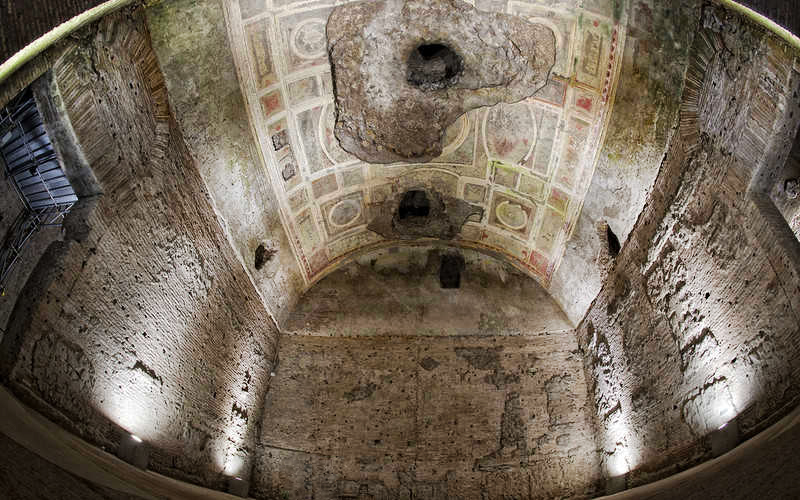A beautifully decorated room has been discovered at Emperor Nero’s famed Domus Aurea (Golden House) in Rome and brought back to light after 2,000 years. The room is decorated with panthers, centaurs and a sphinx. Experts chanced upon the fresh marvel in the fabled palace while they were doing restoration work on the vault of a neighboring part of the structure.
The enormous house was built by the controversial emperor built in 64 AD after the great fire that devastated Rome. Archeologists dubbed the new area “the Sphinx Room.” The discovery was made thanks to a platform that had been built to restore the vault of an area known as Room 72, one of the 150 rooms rediscovered in the sprawling and sumptuous complex.
“We came across a large opening positioned in the northern corner of the covering of the room,” said Alessandro D’Alessio, the official in charge of the Domus Aurea. “Lit up by the artificial light, there suddenly appeared the entire barrel vault of a completely frescoed adjacent room,” he said.
Much of the room, which is rectangular, is covered in rich decoration including the vault. The room is still underground, buried by tons of earth on the orders of Emperor Trajan, who built luxurious baths over Nero’s former palace. The earth will remain on top of the room because of fears for the stability of the complex.
Among the decorations is the room are elegant small figures divided into pictures bordered in red and golden yellow, painted on a white background. The Roman god Pan, one of Nero’s favorites, is depicted in one scene, while in another, a man armed with a sword, quiver and shield is shown fighting a panther. The artwork that has given rise to the room’s name, shows a small sphinx standing on a pedestal. There are also stylized aquatic creatures, both real and imagined, architectural motifs of the time, garlands and branches of trees with delicate green, yellow and red leaves, as well as flowers, fruit and birds.
Much of the same type of decoration is also found in the Domus on the Colle Oppio and in other rooms of the Golden House including one known as Cryptoporticus 92. This has led experts to attribute the Room of the Sphinx to the same workshop of craftsmen who were known to have worked in the Domus Aurea between 65 and 68 AD.
The golden palace first re-opened in June 1999, but from 1978 until the public opening, it was regarded as Rome’s best-kept secret and was only open to art officials and special guests. Millions were spent were spent refurbishing the rooms, which are filled with frescoes of fanciful animals, such as winged lions, griffins and tritons. Architecturally, the Domus’s most outstanding feature is the eight-sided Sala Ottagonale, where Nero is supposedly entertained his guests with song, while playing his lyre. The room was equipped with sliding marble panels on the walls and even a rotating floor.
When the Domus was completed, it encompassed 50 hectares and covered much of the neighboring Palatine and Celian hills. The notoriously self-centered emperor is reputed to have remarked that he finally was beginning to be housed like a human being when the building was completed. However, not long after, Nero committed suicide. The Flavian emperors who succeeded him proceeded to bury all traces of his legacy. The Flavian amphitheater, better known as the Colosseum, was built on the site of Nero’s palace-side lake, while Trajan built his baths on top of the main part of the Domus.
The Colosseum is so-called because of the massive (colossal) statue of Nero, depicted as the god Apollo. His successors recycled the statue by changing its head and placed it beside the new arena, which took its name from the colossus at its entrance.
The Domus has an important place in later Italian art history. Renaissance artists including Raphael and Michelangelo lowered themselves through the oculus on ropes to gaze at and copy the ancient wall drawings. This represented a rediscovery of perspective painting and an acknowledgement of how advanced and sophisticated Roman art was.





